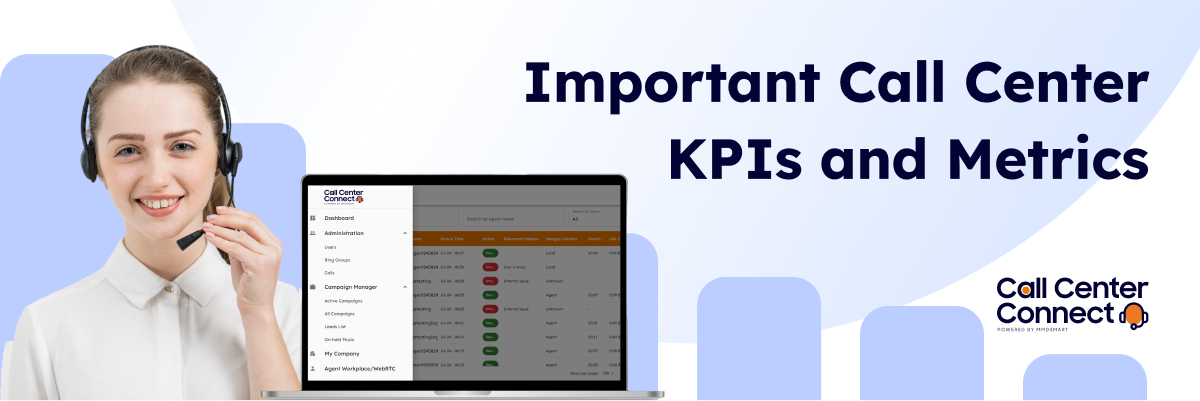Important Call Center KPIs and Metrics

In the dynamic landscape of customer service, call centers play a crucial role in maintaining customer satisfaction and fostering loyalty. To ensure these operations run smoothly and efficiently, it is essential to monitor and evaluate performance using Key Performance Indicators (KPIs) and metrics. These KPIs and call center metrics serve as vital tools for measuring the effectiveness of call center communications and activities, identifying areas for improvement, and making data-driven decisions to enhance overall performance.
Understanding and leveraging the right call center performance metrics can lead to significant improvements in customer experience, operational efficiency, and business outcomes. This blog will provide an overview of the most important call center KPIs and metrics, highlighting their role in optimizing call center performance and driving success. Whether you are a call center manager, a business owner, or an industry professional, understanding these metrics is key to achieving excellence in customer service.
Learn more about Call Center Connect, MMDSmart’s cloud based call center
What are the 4 Common Call Center KPIs?
There are several Key Performance Indicators that stand out for their ability to provide valuable insights into the performance and efficiency of call center operations. These are:
- Average Handle Time
- First Call Resolution
- Customer Satisfaction Score
- Net Promoter Score
Each of these metrics plays a crucial role in assessing different aspects of call center performance.
1. Average Handle Time
Average Handle Time (AHT) measures the average duration of a customer interaction, including the time spent on the call and any post-call work. It is calculated by adding the total talk time, hold time, and after-call work time, then dividing by the number of calls handled. AHT is a critical metric for understanding the efficiency of call center operations.
AHT is essential for measuring operational efficiency. A lower AHT indicates that agents are resolving issues quickly, which can lead to cost savings and higher productivity. However, it is crucial to balance AHT with service quality to avoid rushing interactions. Maintaining this balance with thorough and empathetic service is key to maintaining high service quality.
2. First Call Resolution
First Call Resolution (FCR) measures the percentage of customer inquiries or issues that are resolved during the first interaction, without the need for follow-up calls. It is an important call center metric of call center effectiveness, reflecting the ability of agents to address customer needs promptly and accurately.
High FCR rates indicate that customers’ issues are being resolved on the first contact, leading to higher customer satisfaction and reduced call volumes. FCR is a direct reflection of an agent’s competency and the effectiveness of support processes.
High FCR rates contribute to better customer experiences by resolving issues quickly and reducing the need for multiple interactions. This not only enhances customer satisfaction but also improves operational efficiency.
3. Customer Satisfaction Score
Customer Satisfaction Score (CSAT) gauges customers’ satisfaction with the service they received. Typically measured through post-interaction surveys, CSAT provides direct feedback from customers about their experience. This metric is vital for understanding how well the call center meets customer expectations.
CSAT is a direct measure of customer happiness. High CSAT scores indicate that customers are satisfied with the service they received, which can lead to increased customer retention and positive word-of-mouth.
By consistently monitoring and improving CSAT, call centers can ensure that they meet and exceed customer expectations, leading to higher satisfaction and loyalty.
4. Net Promoter Score
Net Promoter Score (NPS) measures customer loyalty by asking how likely customers are to recommend the company to others on a scale from 0 to 10. Customers are classified into promoters, passives, and detractors based on their responses. NPS is a powerful indicator of overall customer sentiment and loyalty.
A high NPS is a strong indicator of customer advocacy, which can drive growth through referrals and repeat business. NPS impacts the long-term success of the company by measuring customer loyalty and advocacy.
Visualize KPIs through Call Center Connect’s Interactive Dashboards
How Dashboards Serve Managers and Agents
Dashboards are powerful tools that provide real-time insights into call center operations, benefiting both managers and agents by facilitating decision-making and performance monitoring.
For managers, dashboards allows them to quickly identify trends, spot potential issues, and respond proactively to ensure service levels are maintained. This real-time monitoring capability enables data-driven decision-making, where managers can optimize operations by reallocating resources, adjusting schedules, and implementing process improvements.
Additionally, dashboards help managers track the performance of individual agents and teams, making it easier to identify top performers, recognize areas needing improvement, and develop targeted training programs. Managers can set performance goals and benchmarks based on dashboard data, maintaining high standards and driving continuous improvement within the call center.
For agents, dashboards provide the ability to self-monitor performance in real-time, fostering a sense of accountability and motivating them to improve their service delivery. Immediate feedback on key performance metrics allows agents to make necessary adjustments to enhance service quality on the spot.
Dashboards also help agents understand their performance targets and track their progress toward achieving these goals, which can lead to increased motivation and job satisfaction.
In practice, dashboards have proven invaluable in various real-world scenarios. For example, a financial services call center utilized dashboards to enhance customer satisfaction by providing managers with real-time data on call handling times and resolution rates. This enabled them to quickly identify bottlenecks and allocate resources more efficiently.
Agents, in turn, used the dashboards to monitor their own performance, receive immediate feedback, and access resources that helped them resolve customer inquiries more effectively.
As a result, the call center saw a significant improvement in customer satisfaction scores and a reduction in average handle times.
Similarly, a telecommunications provider used dashboards to track the performance of their customer service teams, allowing managers to set clear performance goals and benchmarks. Agents were able to see their progress in real-time, which motivated them to improve their performance and contributed to a noticeable increase in first call resolution rates.
These examples illustrate how dashboards can serve as vital tools for both managers and agents, driving performance optimization and enhancing the overall quality of call center solutions and services.
Deploy your call center in less time than it took to read this blog. Click here to get started!

Strategies for Tracking and Analyzing Call Center Performance
Tracking Tools
In today’s data-driven world, the use of advanced tracking tools and software is essential for monitoring call center performance metrics. These tools provide real-time insights and comprehensive data, allowing managers to make informed decisions. Key tracking tools include:
- Customer Relationship Management (CRM) Systems CRMs help in tracking customer interactions, sales, and support requests. They provide a holistic view of customer journeys and agent performance.
- Call Monitoring Software Solutions that enable the monitoring of live calls, offering features such as call recording, whisper coaching, and barge-in capabilities.
- Performance Dashboards Business intelligence tools can integrate with various data sources to create customizable dashboards that display key performance indicators (KPIs) in real-time.
- Workforce Management (WFM) Systems Software helps forecast call volumes, scheduling agents, and managing adherence to schedules, ensuring optimal staffing levels.
Analytical Techniques
Analyzing performance data is crucial for identifying trends, strengths, and areas needing improvement. Effective analytical techniques include:
- Trend Analysis Historical data helps identify patterns and trends, which is useful in forecasting future call volumes and preparing for peak times.
- Root Cause Analysis (RCA) Identifies the underlying reasons for performance issues, enabling call centers to address problems at their source.
- Predictive Analytics Forecasts future events based on historical data to predict call volumes, customer behavior, and agent performance.
- Sentiment Analysis Analyze emotions conveyed in customer interactions to gauge customer satisfaction and identify areas for improvement.
- Benchmarking Compare performance metrics against industry standards or competitors to identify gaps and set realistic performance goals.
Continuous Improvement
Continuous improvement is a vital strategy for maintaining and enhancing call center performance. This involves regular reviews and adjustments based on performance metrics. Key strategies include:
- Regular Performance Reviews Conduct monthly or quarterly performance reviews to assess progress, identify issues, and plan corrective actions.
- Feedback Loops Implement feedback loops between managers and agents to ensure that performance feedback is timely and constructive.
- Training and Development Ongoing training programs based on performance data help in addressing skill gaps and improving agent competencies.
- Process Optimization Continuously analyzing and refining call center processes can lead to increased efficiency and better customer service.
- Employee Engagement Regularly soliciting feedback from agents, recognizing their achievements, and involving them in decision-making processes can boost performance.
By leveraging advanced tracking tools, employing effective analytical techniques, and committing to continuous improvement, call centers can achieve high levels of performance, leading to enhanced customer satisfaction and operational efficiency.

Features of a High-Performing Call Center
A high-performing call center ensures smooth operations, exceptional customer experiences, and optimal use of resources. Efficient processes are key, as streamlined workflows and well-defined procedures enable handling high call volumes and ensuring consistency. This efficiency reduces wait times, minimizes errors, and enhances overall productivity.
Effective use of technology is crucial, with advanced tools like CRM systems, performance dashboards, and quality management software playing significant roles. Leveraging technologies such as artificial intelligence, machine learning, and automation allows call centers to handle tasks more efficiently, contributing to better resource management and decision-making.
Best Practices
Here are some best practices for ensuring top-notch call center performance metrics:
- Agent Training and Development Continuous training is essential for maintaining a high-performing call center. Providing agents with regular training sessions on customer service skills, product knowledge, and communication techniques ensures they are well-equipped to handle diverse customer needs.
- Process Optimization Regularly process reviews can lead to significant improvements in efficiency and service quality. This includes analyzing workflows to identify bottlenecks, automating repetitive tasks, and implementing best practices for call handling.
- Technology Integration Leveraging the latest call center technologies is crucial for maintaining a competitive edge. Integrating advanced tools can improve operational efficiency and decision-making.
- Performance Monitoring and Feedback: Implementing and reviewing KPIs helps in identifying areas for improvement and celebrating successes.
- Customer Feedback and Engagement Conduct satisfaction surveys, monitor social media channels, and utilize feedback tools to understand customer needs and preferences.
- Employee Engagement and Well-being A high-performing call center recognizes the importance of its workforce.
By implementing these best practices, call centers can achieve high performance, leading to improved customer satisfaction, increased efficiency, and a more motivated and skilled workforce.
Call Center Connect was designed to drive higher ROI. Learn more.
Achieving Call Center Success Through Key Metrics
Average Handle Time, First Call Resolution, Customer Satisfaction Score, and Net Promoter Score are essential metrics for any call center striving for excellence. These call center metrics provide critical insights into various aspects of performance, from operational efficiency to customer satisfaction and loyalty. By understanding and monitoring these metrics, call centers can identify areas for improvement, make informed decisions, and implement strategies that enhance overall performance and customer experience.
Call center managers are encouraged to focus on rigorous KPI tracking and analysis. Embracing these metrics and integrating them into regular performance reviews can drive continuous improvement and optimization. By leveraging advanced tools and technologies, and committing to best practices in agent training, process optimization, and customer engagement, call centers can achieve significant gains in efficiency, customer satisfaction, and business success. Now is the time to prioritize KPI tracking and analysis, ensuring your call center operates at its highest potential and delivers exceptional customer service.
Call Center Connect Includes a Full Monitoring and Stats Toolset
And read about the differences between traditional and virtual call centers.








